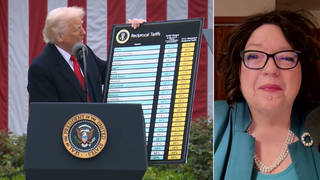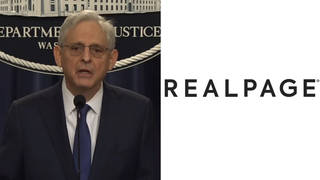
Guests
- Nomi Prinsformer managing director at Bear Stearns and Goldman Sachs and previously an analyst at Lehman Brothers and Chase Manhattan Bank.
We get reaction to this week’s Senate Banking Committee hearing where Senator Elizabeth Warren grilled Wells Fargo CEO John Stumpf over a growing scandal at the major Wall Street bank involving thousands of employees who took private customer information to create 2 million fake accounts in order to meet sales targets. The scandal dates back to at least 2011, and CEO John Stumpf admits he’s known about the practice since 2013. Wells Fargo has been fined $185 million. “John Stumpf let 5,300 people take the fall for his criminal behavior,” says Nomi Prins. Prins is a former managing director at Bear Stearns and Goldman Sachs and previously an analyst at Lehman Brothers and Chase Manhattan Bank. Prins’s latest book is called “All the Presidents’ Bankers: The Hidden Alliances That Drive American Power.”
Transcript
JUAN GONZÁLEZ: On Tuesday, Massachusetts Senator Elizabeth Warren grilled Wells Fargo CEO John Stumpf during his two-hour testimony to the Senate Banking Committee over a growing scandal at the major Wall Street bank involving thousands of employees who took private customer information to create 2 million fake accounts in order to meet sales targets. The scandal dates back to at least 2011, and CEO John Stumpf admits he’s known about the practice since 2013. Wells Fargo has been fined $185 million. Senator Elizabeth Warren called on Stumpf to be investigated.
SEN. ELIZABETH WARREN: Do you know how much money, how much value your stock holdings in Wells Fargo gained while this scam was underway?
JOHN STUMPF: Well, first of all, it was not a scam. And cross-sell is a way of deepening relationships. When customers—
SEN. ELIZABETH WARREN: We’ve been through this, Mr. Stumpf. I asked you a very simple question: Do you know how much the value of your stock went up while this scam was going on?
JOHN STUMPF: Yeah, it’s—all of my compensation is in our public filing.
SEN. ELIZABETH WARREN: Do you know how much it was?
JOHN STUMPF: It’s all in the public filing.
SEN. ELIZABETH WARREN: All—you’re right. It is all in the public records, because I looked it up. While this scam was going on, you personally held an average of 6.75 million shares of Wells stock. The share price during this time period went up by about $30, which comes out to more than $200 million in gains, all for you personally—and thanks, in part, to those cross-sell numbers that you talked about on every one of those calls. You know, here’s what really gets me about this, Mr. Stumpf. If one of your tellers took a handful of $20 bills out of the cash drawer, they’d probably be looking at criminal charges for theft. They could end up in prison.
JUAN GONZÁLEZ: More of Massachusetts Senator Elizabeth Warren grilling Wells Fargo CEO John Stumpf during his two-hour testimony to the Senate Banking Committee Tuesday. She called on him to resign.
SEN. ELIZABETH WARREN: But you squeezed your employees to the breaking point, so they would cheat customers and you could drive up the value of your stock and put hundreds of millions of dollars in your own pocket. And when it all blew up, you kept your job, you kept your multimillion-dollar bonuses, and you went on television to blame thousands of $12-an-hour employees who were just trying to meet cross-sell quotas that made you rich. This is about accountability. You should resign. You should give back the money that you took while this scam was going on. And you should be criminally investigated by both the Department of Justice and the Securities and Exchange Commission.
AMY GOODMAN: That was Massachusetts Senator Elizabeth Warren grilling Wells Fargo CEO John Stumpf earlier this week. The Consumer Financial Protection Bureau found Wells Fargo employees secretly opened phony bank accounts, issued credit cards to customers who did not want them. These practices led to overdraft charges, late fees, other penalties. The bank has fired at least 5,300 workers allegedly involved in the illegal activity. But not a single high-level executive has been fired or even forced to return the tens of millions of dollars in pay earned based on the fraud.
For more, we’re going to Los Angeles to speak with Nomi Prins, former managing director at Bear Stearns and Goldman Sachs, previously an analyst at Lehman Brothers and Chase Manhattan Bank. Her latest book, All the Presidents’ Bankers: The Hidden Alliances That Drive American Power.
Welcome to Democracy Now!, Nomi. Can you talk about this case and what will come of this hearing, what exactly John Stumpf did, the head of Wells Fargo, where he remains?
NOMI PRINS: What John Stumpf did is he let 5,300 people take the fall for his criminal behavior. That’s what he did. This particular case that was in front of the Senate Banking Committee early this week is a tiny portion of the array of criminal activity that Wells Fargo has basically done under the direction of John Stumpf. John Stumpf has been the CEO since 2007. He has been chairman of the board of Wells Fargo since 2010. He has been there through the beginning of the financial crisis ’til now, and he has presided not just on this case, where 5,300 people were involved in technically possibly creating phony accounts for credit cards and for depositors in order to charge fees, in order to make those cross-sell objectives, that are set on high, but for years he was knowledgeable of it. And during those years, Wells Fargo racked up about $10 billion. This fine, on this particular set of activities, was only $185 million. Wells Fargo has racked up $10 billion worth of fines for criminal activity, from foreclosure abuses to defrauding the government to abusing Hispanic and African-American communities with respect to mortgage-related activities. They have done an array of crimes, all under John Stumpf. He has let, in this particular case, 5,300 people take the fall for one of them.
JUAN GONZÁLEZ: Well, Nomi, you mention other previous cases. There was an article in yesterday’s New York Times about some of those mortgage fraud cases, where, in fact, Gretchen Morgenson quotes a federal judge in 2013 demanding that the bank provide him with a corporate resolution signed by its president and a majority of its board stating that they stood behind the conduct of the bank’s lawyers in one particular case. That judge said, “The disconnect between Wells Fargo’s publicly advertised face and its actual litigation conduct here could not be more extreme.” So, this is, as you say, a serial situation of the bank. And yet, why did, do you think, the federal government end up with such a low fine, and still, again, no—even though they claim that they’re doing a criminal investigation, no sense that anyone’s actually going to be indicted for what happened here?
NOMI PRINS: Because in this case, and throughout all those multiple cases, of which Wells Fargo and all our other large banking institutions, I might add, have been involved in in different ways, the government refuses to prosecute any of these people, because it doesn’t want to. If you and I and Amy were sitting there committing grand larceny across state lines, we would not only walk out—we wouldn’t be in that room, right? We’d be walking out of that room, we’d be serving some serious jail time. But in the case of these people, they not only have committed crimes by directing crimes—that’s what happens when you are going through—you take your minions, and you just sort of direct them to do your bidding.
In John Stumpf’s case and in that mortgage case that you’re talking about, Juan, that was related to a $5.2 billion settlement that Wells Fargo did with the Department of Justice. And as part of that settlement, it was supposed to provide certain information and stop certain abuses. It was actually recharged by the attorney general in New York for not complying with its settlement. This was in 2012. This is where John Stumpf was supposedly knowledgeable of this other smaller crime and not doing anything about it. He should have walked out of that Senate committee, been handcuffed, been indicted and had all of these multiple charges put upon him as the director of this institution.
AMY GOODMAN: Nomi Prins, I wanted to switch gears to ask you about Donald Trump. Donald Trump, a recent Washington Post investigation found, used, among other things, about a quarter of a million dollars, $258,000, from his family foundation, the Donald J. Trump Foundation, to pay off legal fees associated with his businesses, which is illegal under U.S. law.
NOMI PRINS: Right. This is basically—you’re not supposed to take a charitable foundation and cross over the line into supporting your business dealings. What he did in the case of $285,000 worth of activities is he did that. And these are only the ones that we know about. But the pattern actually is not dissimilar to the pattern of Wells Fargo, which is effectively using other people’s money to meet his business obligations to make him either richer or to make problems go away, which is what he did in those cases and which it is likely he has done in many other cases. It shows a particular pattern of behavior where you find money in one place, that you shouldn’t be using, that you legally should not be using, and you use that to effect profit in another location. That’s what he did in those cases.
AMY GOODMAN: And he did not—hasn’t given to his own foundation in years, so he is spending—well, as he puts it, OPM, other people’s money.
NOMI PRINS: Exactly. And this is something we need to be concerned about if he were to be elected president. If you can find and use other people’s money illegally in one capacity, then you have the skill and you have the track record to do that in other types of capacities. He has done that not just in his charitable—you know, with respect to his charitable foundation. He has used money to effectively buy off government officials in order to make certain legal settlements related to his private business enterprises go better for him. You know, he’s basically funded, whether it’s political people or whether it’s in certain court cases, individuals behind the scenes to be able to effect a positive outcome for his businesses. So it’s not just in charities, it’s in public offices, as well, in which he has used his money to benefit his private interest. So there’s no doubt that that pattern exists. That’s proven. That’s real information. That’s not a conspiratorial accusation. And that is something for which he has been doing for, extensively, decades.
JUAN GONZÁLEZ: And, Nomi, I’d like to ask you—we’re heading into the last few months of the Obama administration. The title of your new book is All the Presidents’ Bankers, “presidents” with the plural, so you’re dealing with all past presidents. But how do you assess the record of the Obama administration in dealing with the criminal activity and the fraud of so many of the major banks in this country?
NOMI PRINS: Well, we just talked about John Stumpf at the beginning of this. The Obama administration has not gotten behind prosecuting any of the individuals at the top of these banks. So we basically have three sets of individuals at the head of three of the six largest banks in the country—we have John Stumpf at Wells Fargo, we have Lloyd Blankfein at Goldman Sachs, and we have Jamie Dimon at JPMorgan Chase—who have not only benefited from the post-crisis environment and what the government has allowed them to get away with, their institutions have all grown and flourished, as they’ve been paying very small settlements related to what their profits are to the United States government. So the Obama administration has done a very poor job of handling the criminality of the banking system, of changing the banking system, of personally making responsible, on a—from a criminal basis, the individuals that run the largest institutions in this country.
In addition, it has not broken up the banks. We have a situation where these large banks and these individuals control so many assets and so many deposits of the American people, because they are allowed to do so because of our regulatory framework. Our regulatory framework in the post-Glass-Steagall-repeal environment, which happened under Bill Clinton, before Obama came into power, still exists. That’s why there is so much power in these institutions. That’s why these individuals get away with so much. And that’s why the Obama administration has done a very poor job of changing any of that for the benefit of our country or for economic stability going forward.
AMY GOODMAN: Elizabeth Warren called for John Stumpf to resign and to be criminally investigated. What do you think actually will happen?
NOMI PRINS: I think he will do none of those. He has not—well, he might be criminally investigated. But as we’ve seen, that, A, hasn’t happened, so that makes a very, very low probability. And if he is, remember all the money that he has made, and that Elizabeth Warren talked about that he’s made during this period, and not just from this crime but from all the multiple ones that have led to those $10 billion worth of settlements, have not only enriched him, but even the fines for them have not come out of his own pocket. He’s had zero accountability, zero cost to himself personally, zero reason to resign.
And the other reason for not resigning is he runs the board there. Normally, in a situation in a company where you’re talking about a resignation, there’s a board decision, there’s an analysis of what’s going on in the company, there’s a recommendation to keep or get rid of a CEO. None of that’s happened, because he runs the board. And this is the case in other banking institutions, as well.
AMY GOODMAN: We’re going to—
NOMI PRINS: So, this is Jamie Dimon at JPMorgan Chase and so forth. But he runs the board—
AMY GOODMAN: We’re going to have to leave it there. But, Nomi Prins, thanks so much for being with us.
NOMI PRINS: —so that’s why it’s very unlikely he’ll resign. That’s why it’s very unlikely we’re going to see him in cuffs or indicted.
AMY GOODMAN: We have to wrap up. I’m Amy Goodman, with Juan González, for another edition of Democracy Now!












Media Options